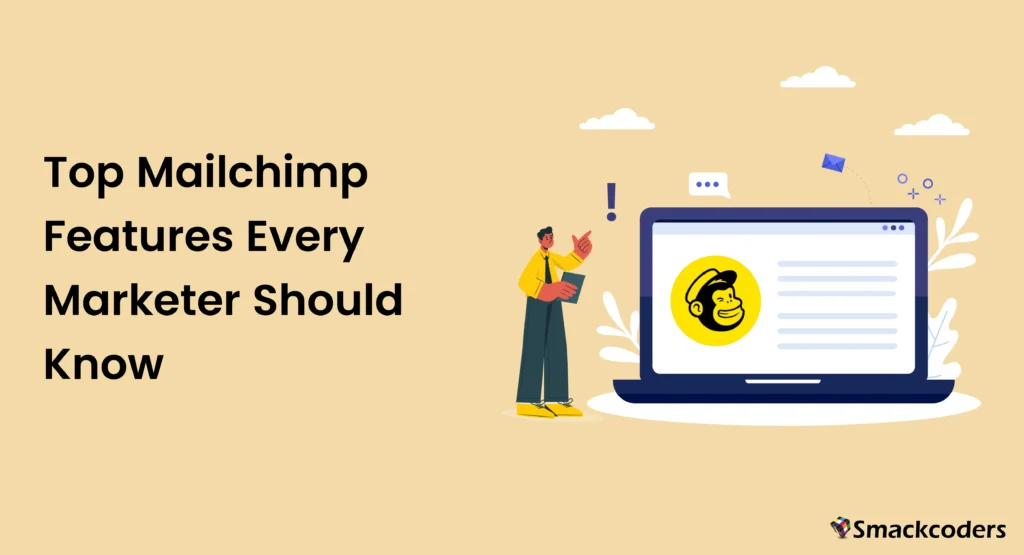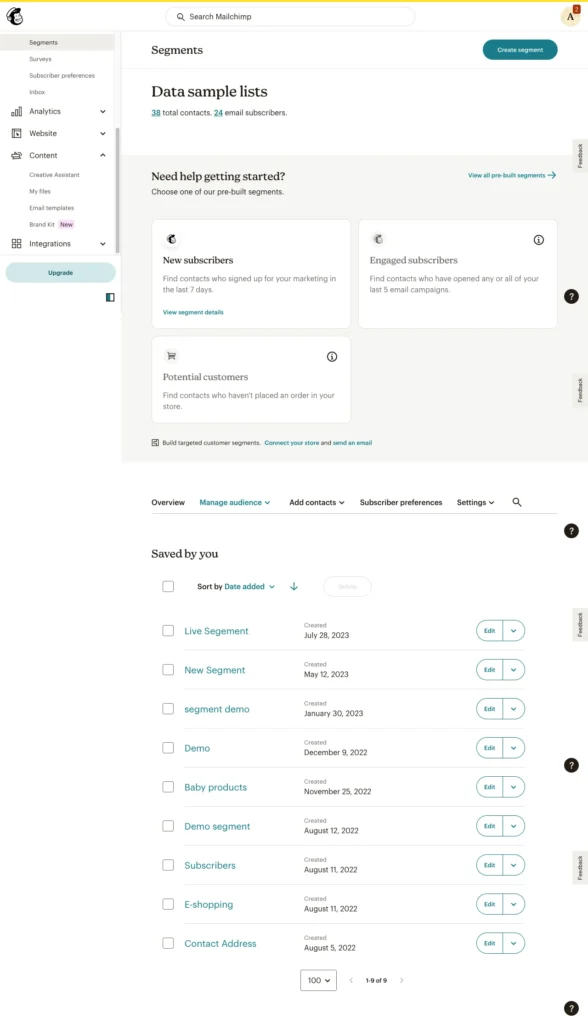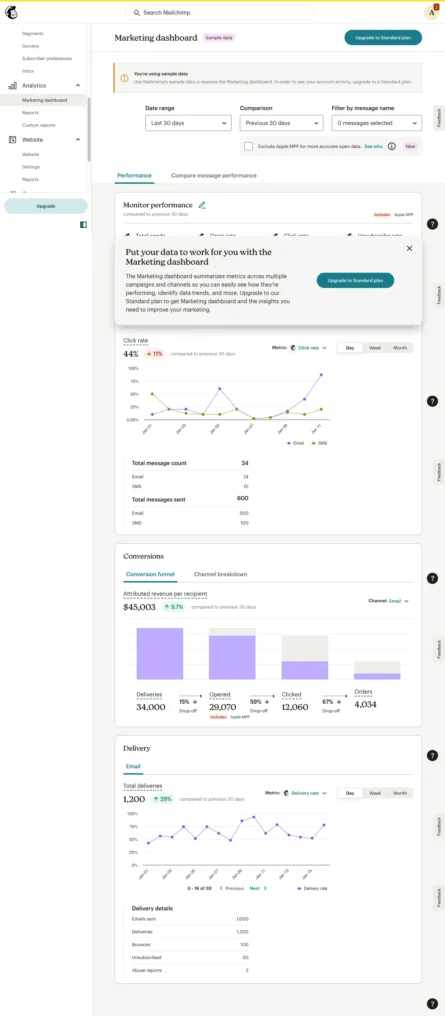
Table of Contents
Introduction
In the rapidly evolving digital marketing landscape, staying ahead of the curve requires leveraging powerful tools that can streamline processes and maximize results. Mailchimp stands out as a leading email marketing platform, offering a plethora of features designed to enhance marketing campaigns and drive engagement. This blog post delves into the top Mailchimp features every marketer should know to improve their email marketing strategies.
Importance of Using Mailchimp
Mailchimp has revolutionized email advertising with its consumer-pleasant interface and comprehensive suite of tools. Whether you’re a small business owner or a seasoned marketer, understanding the importance of using Mailchimp can significantly boost your marketing efforts. Here’s why:
- User-Friendly Interface: Simplifies the email creation process with intuitive tools.
- Scalability:
- Versatility: Supports various marketing activities beyond email, including social media ads and landing pages.
- Cost-Effectiveness: Offers a range of pricing plans to fit different budgets, including a free tier with essential features.
By leveraging Mailchimp, marketers can achieve higher engagement rates, better customer segmentation, and more effective campaign management. The platform’s comprehensive suite of features ensures that you can handle everything from simple newsletters to complex automated workflows, all within a single interface.
Overview of Mailchimp’s Capabilities
Mailchimp offers an array of abilities that empower marketers to create, manage, and analyze their email marketing campaigns effectively. Some key capabilities include:
- Email Marketing: Create and send attractive emails effortlessly.
- Marketing Automation: Automate repetitive tasks or responsibilities and nurture leads.
- Audience Management: Segment and manage your audience effectively.

- Analytics and Reporting: Gain insights into your marketing campaign performance.
- Integrations: Connect with various third-party platforms for enhanced functionality.
Each of these capabilities is designed to help marketers optimize their efforts, save time, and achieve better results. By understanding and utilizing these features, you can take your email marketing to the next level.
Email Campaign Creation and Design
Creating visually appealing and effective email campaigns is crucial for engagement. Mailchimp provides a robust set of tools to help you design professional-looking emails:
- Drag-and-Drop Builder: Easy to use for creating professional emails without any coding knowledge.
- Templates: Wide range of customizable templates that cater to different industries and purposes.

- Content Blocks: Allows addition of text, images, buttons, and more effortlessly.
- HTML Customization: For advanced users who prefer to code their own designs.
Tips for Effective Email Design:
- Keep It Simple: Avoid clutter and focus on a clean, easy-to-read layout.
- Use High-Quality Images: Ensure that images are clear and relevant to your content.
- Incorporate Branding: Maintain consistency with your brand’s colors, fonts, and style.
- Call to Action: Include a clear and compelling call to action (CTA) that guides the reader.
Audience Management and Segmentation
Effective audience management is key to targeting the right people with the right message. Mailchimp’s features include:
- Segmentation: Allows creation of highly targeted segments based on various criteria such as demographics, behavior, and engagement.
- Tags and Groups: Organize your contacts for better targeting and personalized communication.
- Behavioral Data: Use purchase history, email engagement metrics, and website activity to refine segments.
Strategies for Effective Segmentation:
- Demographic Segmentation: Group your target audience based totally on age, gender, region, and other demographic factors.
- Behavioral Segmentation: Target users based on their past interactions with your emails and website.
- Purchase History: Segment customers who have bought specific products or services.
- Engagement Levels: Focus on active subscribers while re-engaging inactive ones.
Automation Workflows
Automation is a powerful methodology to streamline repetitive tasks/duties and nurture leads. Mailchimp’s automation features include:
- Customer Journeys: Create personalized customer journeys with automated emails tailored to subscriber actions.
- Trigger-Based Emails: Send emails based on specific actions taken by subscribers, such as sign-ups, purchases, or abandoned carts.
- Automated Campaigns: Set up drip campaigns, welcome series, and post-purchase follow-ups to engage subscribers at every stage of their journey.

Common Automation Scenarios:
- Welcome Series: Greet new subscribers with a chain of onboarding emails.
- Abandoned Cart Emails: Remind customers to complete their purchase.
- Re-Engagement Campaigns: Win lower back inactive subscribers with unique gives or content material.
- Birthday Emails: Send personalized birthday greetings with special discounts.
A/B Testing for Optimization
A/B testing allows marketers to test different versions of an email to see which performs better. Mailchimp’s A/B testing features include:
- Variable Testing: Test different elements such as subject lines, content, images, and send times.
- Performance Metrics: Detailed reviews/reports on which model plays great based on open rates, click-through rate, and conversions.
- Optimization Recommendations: Suggestions to improve future campaigns based on test results.
Tips for Effective A/B Testing:
- Test One Element at a Time: Focus on one variable to recognize its effect.
- Use a Significant Sample Size: Ensure you have enough data to make accurate conclusions.
- Monitor Results: Analyze the data to determine which version resonates better with your audience.
- Implement Learnings: Apply insights from A/B tests to optimize future campaigns.
Reporting and Analytics
Understanding the overall performance of your email campaigns is crucial for making data-driven decisions. Mailchimp provides strong reporting and analytics tools:
- Campaign Reports: Insights into open rates, click-through rate (CTR), bounce/jump rates, and more.
- Audience Reports: Understand subscriber behavior, engagement levels, and growth trends.
- Revenue Reports: Track the ROI of your email campaigns, especially if you’re running e-commerce campaigns.

Key Metrics to Monitor:
- Open Rate: Percentage of recipients who open your mail.
- Click-Through Rate: Percentage of recipients who click on links inside your email.
- Bounce Rate: Percentage of emails that couldn’t be added.
- Conversion Rate: Percentage of recipients who take a desired action, such as making a purchase.
- Unsubscribe Rate: Percentage of recipients who choose-out out of your e mail list.
Integration with Third-Party Platforms
Mailchimp integrates seamlessly with numerous third-party platforms, enhancing its functionality:
- E-Commerce Platforms: Shopify, WooCommerce, BigCommerce, and more to sync product data and track sales.
- CRM Systems: Salesforce, HubSpot, and others to manage customer relationships and track interactions.
- Social Media: Integrate with Facebook, Instagram, and Twitter for cross-channel marketing and audience growth.
- Web Analytics: Google Analytics and other tools for tracking website performance and campaign impact.
Benefits of Integrations:
- Streamlined Data Management: Consolidate data from multiple sources for better insights.
- Enhanced Functionality: Leverage additional tools and features from integrated platforms.
- Improved Targeting: Use combined data to create more targeted and effective campaigns.
- Increased Efficiency: Automate data syncing and reduce manual efforts.
Personalization and Dynamic Content
Personalization is key to engaging subscribers. Mailchimp offers advanced personalization features:
- Dynamic Content: Customize e-mail content material primarily based on subscriber information which include area, buy records, and behavior.
- Merge Tags: Personalize emails with subscriber-specific information such as names and preferences.
- Conditional Content: Show different content to different segments within the same email to cater to diverse audience needs.
Personalization Tips:
- Use Subscriber Names: Address recipients by their first name for a personal touch.
- Leverage Behavioral Data: Tailor content based on past interactions and preferences.
- Dynamic Recommendations: Suggest products or content based on subscriber behavior.
- Localized Content: Adjust content to reflect the recipient’s geographical location and language preferences.
Mobile Optimization
With an increasing number of people accessing emails via mobile devices, ensuring mobile optimization is crucial. Mailchimp provides:
- Responsive Design: Automatically adjusts emails for optimal viewing on mobile devices.
- Mobile Preview: See how your emails will look on mobile before sending.
- Mobile-Friendly Templates: Designed especially for cell viewing, ensuring that your emails appearance terrific on any device.
Best Practices for Mobile Optimization:
- Simplify Your Design: Use a single-column layout and large fonts for readability.
- Optimize Images: Ensure images load quickly and display correctly on mobile screens.
- Shorten Subject Lines: Keep subject lines concise to fit within mobile screens.
- Clickable CTAs: Use large, tappable buttons for calls to action.
Compliance and Security
Maintaining compliance and ensuring data security is critical. Mailchimp helps with:
- GDPR Compliance: Tools to help comply with GDPR regulations, including customizable consent forms and data management options.
- Secure Data Handling: Robust security measures, such as encryption and secure access protocols, to protect subscriber data.
- Opt-In Forms: Ensure consent with customizable opt-in forms, double opt-in processes, and subscription confirmation emails.
Best Practices for Compliance:
- Get Explicit Consent: Use clear, unambiguous language in your opt-in forms.
- Provide an Easy Opt-Out: Provide a link to unsubscribe in each email sent as part of the marketing campaign.
- Keep Data Secure: Regularly update security protocols and reveal potential breaches.
- Stay Informed: Keep up-to-date with the latest regulations and best practices for data privacy.
Customer Support and Resources
Mailchimp offers excellent customer support and a wealth of resources:
- 24/7 Support: Access to customer service through chat and email, ensuring assistance is constantly to be had when needed.
- Knowledge Base: Extensive articles, guides, and tutorials to help you get the most out of Mailchimp’s features.
- Community Forums: Connect with other Mailchimp users for tips, advice, and shared experiences.
- Webinars and Training: Participate in live or recorded sessions to learn more about Mailchimp and email marketing best practices.
Tips for Utilizing Support Resources:
- Search the Knowledge Base: Often, you can find quick answers to your questions.
- Engage in Forums: Share experiences and learn from other users.
- Attend Webinars: Stay updated on the brand new functions and fine practices.
- Contact Support: Don’t hesitate to reach out for personalized assistance.
Advanced Features and Future Developments
Mailchimp continually evolves, offering advanced features and keeping an eye on future developments:
- AI-Powered Tools: Predictive insights and recommendations that help optimize your campaigns.
- Advanced Segmentation: Even more refined targeting options based on a variety of data points.
- Ongoing Updates: Regular feature updates and improvements will keep the platform at the cutting edge of email marketing technology.
Future Trends to Watch:
- Enhanced AI Capabilities: More sophisticated tools for predicting subscriber behavior and automating personalized content.
- Deeper Integrations: Expanded partnerships with other software platforms to provide even more seamless functionality.
- Increased Automation: Further development of automation features to save time and improve efficiency.
- Advanced Analytics: More specific and actionable insights into campaign overall performance and client behavior.
Conclusion
Mailchimp stands out as a powerful email marketing tool that can significantly enhance your marketing efforts. By leveraging its extensive features—from campaign creation and segmentation to automation and analytics—marketers can achieve better results and drive greater engagement. Whether you’re just starting or looking to optimize your existing strategies, understanding and utilizing Mailchimp’s features is a crucial step towards email marketing success.
FAQs
What is Mailchimp used for?
Mailchimp is a comprehensive email marketing platform that helps businesses create, send, and analyze email campaigns.
How does Mailchimp help in segmentation?
Mailchimp offers advanced segmentation tools that allow marketers to create highly targeted email lists based on various criteria, such as behavior, demographics, and engagement.
What are Mailchimp’s automation workflows?
Mailchimp’s automation workflows enable users to set up automated email sequences triggered by specific subscriber actions, enhancing the efficiency and personalization of marketing campaigns.
Is Mailchimp suitable for small businesses?
Yes, Mailchimp is highly scalable and offers features that cater to both small businesses and large enterprises, making it a versatile tool for marketers of all levels.
How does Mailchimp ensure data security?
Mailchimp employs robust security measures and compliance tools, including GDPR compliance and secure data handling, to protect subscriber information.
